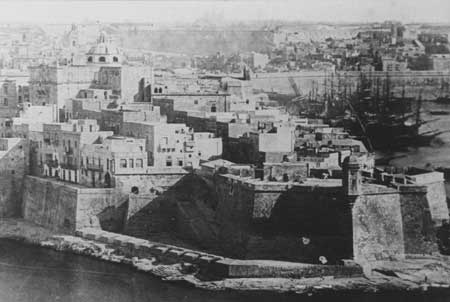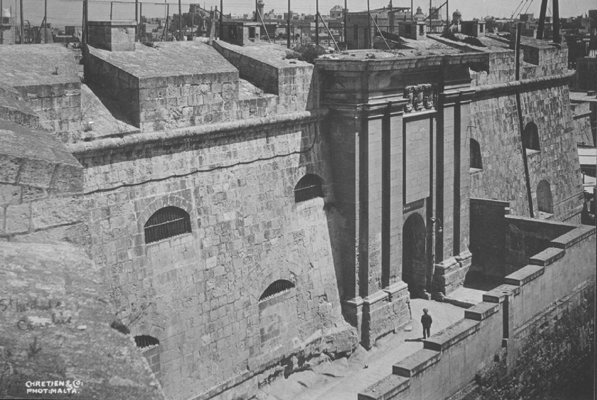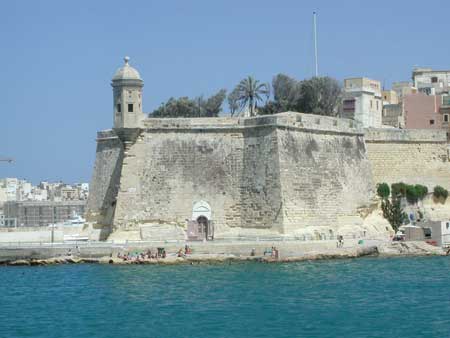 |
|
18th centuary plan of the Senglea landfront fortifications
|
Following the Great Siege, Jean de La Valette (1557-68) bestowed Senglea with the title of Citta Invicta ‘The Unconquered City’ for the courage shown by its citizens. In 1601, he went one step further when he relieved the people of Senglea from paying their land dues. The Siege had caused so much destruction to Senglea that Michelangelo’s assistant Francisco Laparelli recommended razing it to the ground. La Valette ignored this suggestion and saw to the repair of the fortifications – which by 1581 were brought to a reasonable state of defence. La Valette also added new defences to the city, and opened another gate next to ‘Gate Uno’ which had survived the Siege – and which through the years became to be referred to as St Gaetano Gate.
 |
|
Senglea Point and
Grunenberg's Battery
|
Early in the 1600’s, Grand Master Alof de Wignacourt (1601-22) built a massive structure on Sheer Bastion; a form of a wooden crane eventually known as il-Macina. This was used to hoist heavy cargo or galley structures such as masts and lay them ashore for repair. Wignacourt also built a reservoir in the centre of the main road. Antoine de Paule (1623-36) further strengthened the land-front defences by adding a couvre porte, (the third gate) and a counterguard protecting the demi-bastion facing Corradino Hill.
 |
|
St. Anne's Gate,
Senglea's Baroque entrance
|
However by 1655 Senglea’s defences were dilapidated and were described to be in a ruinous state. In an effort to strengthen these defences, artillery platforms were erected on the flank facing Vittoriosa. In 1690 the rocky shore at the foot of Spur Battery was fashioned into a fausse-braye, and the military engineer Don Carlos de Grunenberg financed the construction of a large sea-level battery that was capable of mounting ten guns at the mouth of the Creek facing De Guiral battery beneath Fort St Angelo.
Yet again in the 18th century, Senglea’s fortifications were found to be suffering from ever-increasing neglect. With its military value diminishing rapidly, what in 1565 was one of the bulwarks of Christendom, by 1780 was in serious danger of collapse unless it was urgently repaired. By 1790 the number of guns in the city had been reduced to nine which in 1792 prompted the proposal to install 24 pounder guns in the low battery of Senglea Point. It was thus not surprising that the fortress of Senglea played no part in the events of 1798.
 |
|
Senglea landfront circa 1798
|
At some stage in the early 1700’s, as with Vittoriosa, Senglea also had its own arsenal for the construction of ships of the line, as well as third rate vessels to counter-balance the activity of Muslim ships in the Mediterranean. Consequently, palaces and houses connected with maritime trade are known to have mushroomed. In the second half of the 1800’s, the British demolished the silos built by the Order to make room for the extension of the Dockyard – altering the configuration of the bastions in the process. Consequently, established local shipyards and shipbuilders, such as Sengleans Gregorio Mirabitur, and brothers Lorenzo and Salvatore German, were moved to Marsa. Eventually this necessitated the Admiralty to build a tunnel connecting the Dockyard to Marsa.
During the Second World War, Senglea once again suffered heavy casualties and a lot of buildings, including the Parish Church, were destroyed. The citizens were once again praised for their gallantry when King George VI visited the ruined and devastated city in 1943.
|

|
|
Senglea Point today
|
|
|

|
|
Aerial view from the South
|
|

